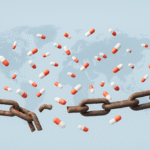Navigating Country-Specific Medical Device UDI Timelines and Regulations
The implementation of Unique Device Identification (UDI) systems around the world is reshaping how medical devices are labeled, tracked, and managed. While the goal is universal—better patient safety, faster recalls, and improved supply chain traceability—the road to UDI compliance is anything but uniform.
At Dolphin Data Capture, we help OEMs and healthcare providers align with evolving UDI requirements through advanced barcode scanning, RFID, and machine vision integration. Below is a consolidated guide to help your team stay informed and ahead of deadlines.
What is UDI and Why It Matters
UDI is a system that uses standardized barcodes to uniquely identify medical devices. It includes:
-
UDI-DI (Device Identifier): The static portion that identifies the labeler and model/version.
-
UDI-PI (Production Identifier): The dynamic portion including lot number, serial number, manufacturing/expiration dates, etc.
The benefits of UDI go far beyond labeling. When scanned and logged properly, UDIs improve:
-
Patient safety through accurate identification and expiration tracking
-
Speed of recalls and adverse event tracing
-
Inventory accuracy and reduction in counterfeit product use
-
Implant traceability and compliance documentation
Global UDI Timelines at a Glance
Below is a summary of major countries and their UDI rollout timelines and requirements:
🇺🇸 United States
-
Regulator: FDA
-
Database: GUDID
-
Status: Fully implemented
-
Class III – Sep 2014
-
Class II – Sep 2016
-
Class I – Sep 2018
-
Reusable Class I – Dec 2022
-
🇨🇳 China
-
Regulator: NMPA
-
Database: China National UDI Database
-
Status: Phased Implementation
-
Class III – Jan 2021 / Jun 2022
-
Class II – Jun 2024 (estimated)
-
Class I – Oct 2026 (estimated)
-
🇪🇺 European Union
-
Regulator: EU MDR / IVDR
-
Database: EUDAMED
-
Status: Rolling out through 2027
-
Class IIa & IIb – May 2023
-
Class I – May 2025
-
IVD Classes B, C – May 2025
-
Class A & reusable devices – May 2027
-
🇧🇷 Brazil
-
Regulator: ANVISA
-
Status: Finalized with extended deadlines (RDC No. 884/2024)
-
Class IV – Jul 2025
-
Class III – Jan 2026
-
Class II – Jan 2027
-
Class I – Jan 2028
-
🇸🇦 Saudi Arabia
-
Regulator: SFDA
-
Database: Saudi-DI
-
Status: Active
-
Class D, B, C – Sep 2023
-
Class A – Sep 2024
-
🇰🇷 South Korea
-
Database: IMDIS
-
Status: Fully enforced
-
Class IV – Jul 2019
-
Class I – Jul 2022
-
🇯🇵 Japan
-
Regulator: MHLW & PMDA
-
Status: Barcode labeling in place since 2022
-
Based on international standards
-
🇮🇳 India
-
Regulator: CDSCO
-
Status: UDI rule announced, implementation pending
-
No firm dates, but Rule 46 is active
-
🇨🇦 Canada
-
Regulator: Health Canada
-
Status: No active UDI system yet, but Medtech Canada supports global harmonization
🇦🇺 Australia
-
Regulator: TGA
-
Database: AusUDID (Pre-Production)
-
Status: Planning for 2025 implementation
🇸🇬 Singapore
-
Status: Active rollout through 2028
-
High-risk: Nov 2022
-
Class D: Nov 2024
-
Class B: Nov 2028
-
🇹🇼 Taiwan
-
Database: TUDID
-
Status: In effect
-
Class III: Jun 2022
-
Class II: Jun 2023
-
General UDI Labeling Requirements
Across all markets, a typical UDI label must be:
-
Human-readable + Machine-readable (barcode/2D Data Matrix)
-
Include both UDI-DI and UDI-PI
-
Conform to recognized issuing agency standards like GS1, HIBCC, or ICCBBA
Staying Ahead: How Dolphin Data Capture Can Help
Keeping up with shifting regulations across markets can overwhelm even the best regulatory teams. That’s where we come in.
Dolphin Data Capture partners with OEMs and global healthcare providers to:
-
Ensure UDI-compliant labeling and barcode selection
-
Integrate scanning hardware and machine vision into packaging lines
-
Provide technical support for Zebra barcode readers and scanners
-
Offer training and troubleshooting to support point-of-care barcode use
Final Thoughts
UDI is more than a compliance checkbox—it’s a strategic advantage when implemented correctly. It empowers healthcare systems with better data, safer operations, and more efficient supply chains.
If your organization manufactures or handles medical devices, now is the time to ensure your systems, labels, and scanning hardware are ready for global UDI requirements.
📞 Ready to upgrade your UDI workflow?
Contact Dolphin Data Capture today for expert integration, product recommendations, and Zebra hardware support tailored to your needs.



